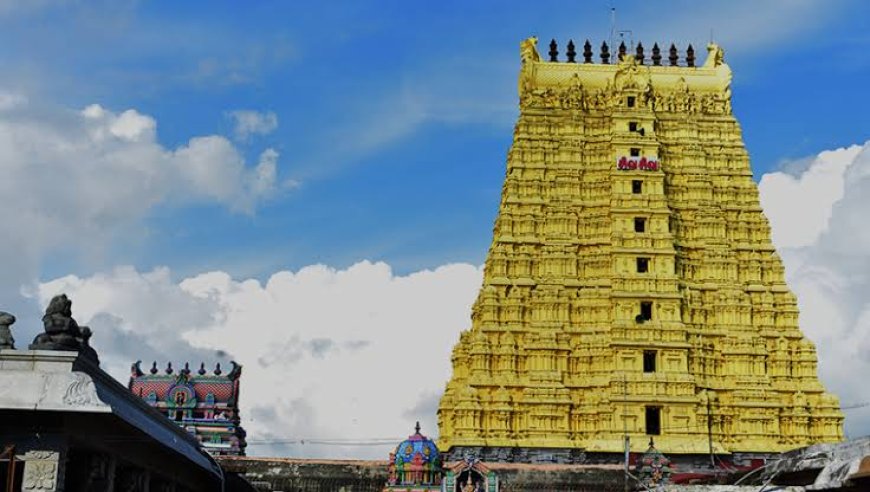Rameshwaram Temple God – Sacred Jyotirlinga of Lord Shiva
Discover the divine essence of Rameshwaram temple god, the sacred abode of Lord Shiva. Explore the temple’s history, significance, and its role as a revered jyotirlinga.

The Rameshwaram temple god holds a revered place in the hearts of millions of devotees who journey from all corners of the world to seek spiritual solace in the sacred town of Rameshwaram, located in the southern state of Tamil Nadu. This temple, dedicated to Lord Shiva, is not just an architectural marvel but also a major pilgrimage site, believed to be one of the holiest shrines in Hinduism. Rooted in mythological grandeur and cultural depth, the temple continues to be a spiritual center where faith, devotion, and tradition unite in harmony.
The Sacred Importance of Rameshwaram Temple
The Rameshwaram temple is among the twelve Jyotirlingas in India, which are considered to be the most sacred abodes of Lord Shiva. It is believed that a pilgrimage to Varanasi is incomplete without paying homage to Rameshwaram, underlining its importance in Hindu religious practice. Devotees believe that by visiting this temple, one can attain spiritual purification and even liberation from the cycle of rebirth.
Situated on Pamban Island, the temple stands as a testimony to South Indias rich spiritual legacy. The town of Rameshwaram itself is deeply intertwined with the Indian epic Ramayana, and it is said that Lord Rama worshipped Shiva here before his journey to Lanka. This makes the temple not only a Shiva shrine but also a bridge between Vaishnavite and Shaivite traditions.
Rameshwaram Temple Jyotirlinga A Pillar of Divine Light
What makes Rameshwaram even more significant is its status as the Rameshwaram temple jyotirlinga. Jyotirlingas are special shrines where Shiva is worshipped in the form of a "linga of light," believed to be self-manifested. Each of the twelve Jyotirlingas represents a different manifestation of Lord Shiva, and Rameshwaram stands out for its unique blend of legend and geography.
The linga at Rameshwaram is said to have been consecrated by Lord Rama himself. According to mythology, when Rama returned from Lanka after defeating Ravana, he wanted to absolve the sin of killing a Brahmin (as Ravana was one), so he worshipped Shiva. He instructed Hanuman to bring a linga from the Himalayas, but as Hanuman was delayed, Rama made a linga from the sand of the seashore. Both lingas are housed in the temple and are worshipped to this day.
Exploring Rameshwaram Temple History
The Rameshwaram temple history is vast and spans several centuries. The temple's foundation is believed to have been laid during the 12th century under the rule of the Pandya dynasty. Over the years, rulers from various dynasties including the Cholas, Nayakas, and Sethupathis contributed to its expansion, giving it the massive scale we see today.
The temple complex is known for its majestic corridorsconsidered the longest among all Hindu temples in Indialined with 1,212 intricately carved granite pillars. These corridors, known as the "Prakaram," stretch over 1,000 meters and echo with spiritual chants and footsteps of pilgrims. The architectural elegance and spiritual ambiance make it not only a place of worship but also a monument of historical importance.
A Spiritual Dip at Beach Rameshwaram Temple
Just a short distance from the temple is the sacred sea shore, often referred to as the beach Rameshwaram temple. It holds special spiritual significance for devotees. It is believed that taking a dip in the waters here, especially at the Agni Theertham, purifies the soul and cleanses all sins.
Devotees often take a ritual bath in these waters before entering the temple premises, as a symbolic act of purification. The tranquil waters of the Gulf of Mannar, along with the golden sands and spiritual chants, create an atmosphere of divine serenity. The connection of sea and spirituality makes Rameshwaram a perfect blend of natural and divine beauty.
The Spiritual Aura of Rameshwaram Shiva Temple
The Rameshwaram Shiva temple is not just about physical grandeur, but about the invisible spiritual energy that envelops the space. Every corner of the temple resonates with prayers, mantras, and the quiet footsteps of thousands of devotees who come with a heart full of faith.
Unlike many other temples, Rameshwaram promotes inclusivity. Pilgrims from various sectsShaivism, Vaishnavism, and even other faithsare welcomed. This reflects the broader spiritual philosophy that the temple embodies, where the divine is accessible to all, regardless of caste, creed, or background.
The Sacred Lingam: Rameshwaram Temple Shivling
The Rameshwaram temple shivling is the central focus of the temple. Worship here begins with rituals that have been passed down for generations. Devotees line up for hours for darshan (holy viewing), to offer water, milk, and flowers to the lingam.
The temple houses two main lingamsthe one made by Rama from sand, and the one brought by Hanuman from Kailash. Worshippers can see both during their visit, and special pujas are held daily. The atmosphere during major festivals like Maha Shivaratri is especially intense, as thousands flock to witness the sacred ceremonies.
Understanding Rameshwaram Jyotirlinga Temple's Legacy
The Rameshwaram jyotirlinga temple stands as a symbol of devotion, mythology, and cosmic balance. It is the only Jyotirlinga located in the southernmost part of India, creating a sacred geographical link with Kashi in the North.
This temple not only connects the physical landscape of India but also bridges diverse spiritual philosophies. Pilgrims from all walks of lifesages, scholars, commonerswalk the grand corridors with equal reverence. It reminds the faithful that the path to the divine is open to all, and that faith knows no boundaries.
Rameshwaram Temple Tamilnadu A Cultural Gem
Located in Rameshwaram temple Tamilnadu, the temple is a glowing beacon of the states rich cultural and spiritual tapestry. Tamil Nadu is known for its ancient temples, classical music, and deep philosophical traditions. Rameshwaram adds another feather to that crown with its unique fusion of mythology, architecture, and ritual.
Visitors not only experience spiritual upliftment but also get to witness the cultural richness of Tamil Nadu through temple festivals, local traditions, and the melodious chants of Tamil hymns. The local cuisine, language, and temple arts add another layer to the pilgrimage, turning it into a journey of both the soul and the senses.
In Conclusion
The Rameshwaram temple god, Lord Shiva, resides in one of the most sacred places in India, drawing millions of hearts toward devotion and enlightenment. The temple is more than just a structure; it is a timeless symbol of faith, tradition, and cultural unity. Whether you're a devout pilgrim or a curious traveler, Rameshwaram offers something profounda space where myth meets history and the soul finds peace amidst ancient stones and divine chants.







































